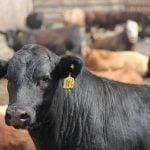Productivity and health data in cow-calf herds is recorded in a variety of ways; everything from sophisticated software programs and spreadsheets to the traditional calving book that may get filed in a drawer once the calves are weaned.
However, we know that keeping and evaluating herd data can help you make better long-term decisions and can be invaluable for making selection decisions.
A recent paper published in the Frontiers in Veterinary Science journal provides valuable data for evaluating herd productivity records.
Dr. Cheryl Waldner and colleagues at the University of Saskatchewan, University of Calgary and University of Montreal analyzed data from 171 Canadian cow-calf herds over multiple years. These herds were all participants in the Canadian Cow-Calf Surveillance Network, a five-year research project funded by the Beef Cattle Research Council.
Read Also

Environmental farm group has Ottawa’s attention
In 2021, Farmers for Climate Solutions published a report on how Canada should reduce emissions from agriculture. Not long after, the federal government implemented most of the recommendations in the report.
The herds were located across Canada with about two-thirds of them in Western Canada. Median herd size was 177 calving cows in Western Canada and 69 calving cows in Eastern Canada.
About 93 per cent of producers kept some production records on paper, almost 50 per cent used a spreadsheet program, 30 per cent used a computer software application and 16 per cent used a smartphone application. Obviously, many producers used more than one method to collect information on their herds.
A unique aspect of this network was that herds provided productivity data over multiple years. Many surveys that evaluate productivity in beef herds often focus on one particular year. However, productivity can vary dramatically from year to year due to drought conditions and forage quality.
Because many of these herds provided up to four years of data, Waldner and her colleagues were able to accumulate well over 500 herd records for many productivity estimates.
For example, there were 563 herd records on calf mortality collected over the four years of the study. The average number of calves that died within 24 hours of birth in these herds was 2.7 per cent.
However, averages are only part of the picture. The herds in the top 25th percentile had only 1.2 per cent of calves die in the first 24 hours and the herds in the bottom 25th percentile had 4.2 per cent die in the first 24 hours.
The highest calf mortality (the 2.5 per cent of herd records with the highest early calf mortality) averaged close to 8.3 per cent of calves dead in the first 24 hours. Clearly these last situations had a significant issue.
Another productivity measure evaluated calf mortality from 24 hours of age to 30 days of age. Again, there were more than 562 herd records, with many herds contributing up to four years of data.
The mean calf mortality for this measure was 1.9 per cent, but once again, this varied from zero to over 14.3 per cent. The top 25 per cent of herds did not lose any calves during this period.
The percentage of females open at pregnancy testing was also recorded and analyzed. The average percentage of open cows was 8.2 per cent or an overall pregnancy rate of about 91.8 per cent.
However, when you evaluate the percentiles, there is significant variation in these numbers as well. The worst five per cent of herds had open rates closer to 20 per cent and the top five per cent had open rates of only 4.3 per cent.
I only have space to touch on a few of the study’s productivity measurements. The journal Frontiers in Veterinary Science has open access and anyone can see the article online if interested in reading more.
This type of productivity data can provide valuable benchmarking information. You can evaluate your herd’s data and compare it to the percentiles in this study to see whether you rank in the top 25 per cent or the bottom 25.
There are always circumstances that influence these production indices that are not in our control, but understanding where you need to improve to at least make national averages is a crucial step.
As Sherlock Holmes stated in A Study in Scarlet: “It is a capital mistake to theorize before one has the data.” We need productivity data and benchmarks to understand what we are doing well and what could be improved upon in our herds.
John Campbell is a professor in the department of Large Animal Clinical Sciences at the University of Saskatchewan’s Western College of Veterinary Medicine.















